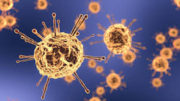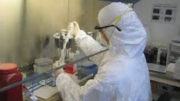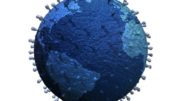Justin Kipness is a senior planning to study biology at Brown University in the fall. Each week, he will trace the Coronavirus pandemic from its origin in Wuhan, China all the way to Stamford, CT. See Part 1, Part 2, and Part 3 to learn how we got here.
CAS Key Laboratory, Wuhan Institute of Virology, Wuhan, Hubei, China, (30.4 N, 114.3 E)
Although science works fast, globalization works faster. By the time samples were being sent from Wuhan, patients were already beginning to experience the signs of a respiratory disease including “fever, dry cough dyspnea, headache, and pneumonia,” according to biorxiv.org. Others, possibly carriers, did not yet experience symptoms great enough to make them seek medical attention. Maybe a few thought they had a common cold. Why would they think otherwise? The severe acute respiratory syndrome (SARS) outbreak was 18 years prior, and it was winter in China.
A doctor took a train to her medical conference. A parent rode the subway. A businessman took a plane. Maybe one of them coughed on another passenger, who took a flight to yet another country. No matter how diligently and fast scientists across the world acted, the virus had already spread.
The pandemic reportedly started on December 12, 2019 according to biorxiv.org, and by January 23, 2020 a group of scientists at the Wuhan Institute of Virology had published a paper which identified the microscopic “spiked” enemy.
Sun Tzu famously said in Chinese military treatise The Art of War over 2,000 years ago, “If you know the enemy and know yourself, you need not fear the result of a hundred battles.” These words are just as applicable in fighting a pandemic as they are on a battlefield. If the Navy is able to decode signals from enemy ships, they can exploit their enemies weaknesses. The same can be said by knowing the virus’s plan of action; if we know how it functions, we can exploit the virus’s vulnerabilities. Molecular scientists would be performing the same function as a spy, only in their case, they would be decoding genetic sequences and protein structures as opposed to Morse code.
Although the scientists at the Wuhan Institute of Virology were able to identify the virus rapidly and identify the cellular receptor the novel coronavirus uses to infiltrate cells – ACE2 as discussed in Part 2 – there is still a lot we do not know about this virus. Other labs across the world waited to get their hands on these precious samples: maybe they could find some new information to help exploit the enemy.
NIH Headquarters, Bethesda, Maryland, U.S.A. (39.0 N, -77.1 E)
The National Institute of Health (NIH) headquarters situated in Bethesda, Maryland sits on Center Drive and resembles a college campus more than a bureaucratic agency. It is even affectionately called the “NIH Campus,” according to nih.gov.
On the same day the paper was published by Wuhan Institute of Virology, a viewpoint was released in Jama, a peer reviewed medical journal, by the National Institute of Allergy and Infectious Diseases (NIAID), a branch of the NIH focused on preventing allergic and infectious diseases.
The viewpoint’s title conveyed the ominous tone and disastrous future ahead: “Coronavirus Infections—More Than Just the Common Cold.” They discussed similarities between the new coronavirus and the SARS outbreak of 2003, stating that during the SARS outbreak, “8,098 individuals were infected and 774 died,” as a warning for the possible future ahead. As of the World Health Organization’s (WHO) April 6 10:00 CET situation report, 1,210,956 have been infected by this new coronavirus and 67,594 have died.
At this time, the ultimate scope of the coronavirus was not known. The extent to which this virus had spread across the world and in America specifically was not known. Westhill High School was still operating. The world was in a different place.
Central Hospital of Wuhan, Wuhan, Hubei, China (30.6 N, 114.3 E)
A 41-year old man finished his shift in the indoor seafood market in Wuhan in late December, 2019. His job remains unclear from papers available. Maybe he sold meat, cleaned the floor, or delivered fish.
In the market, tables were lined with fresh fish and shellfish and a variety of wild animals were for sale, including “hedgehogs, badgers, snakes and birds (turtledoves),” according to scientific journal Nature.
Despite many rumors circulating America, the Chinese Center for Disease Control and Prevention’s (CCDC) epidemiological investigation found that no bats were available to sell, yet genetic testing shows that bats are the likely reservoir host of the novel coronavirus (see Part 2). Interestingly enough, these facts do not contradict each other. Viruses can have complex interactions with ecosystems and can travel from a primary host to an intermediate host that then transmits it to people. This was the case for SARS in 2003, and is possibly the case for this new coronavirus – but more on that in another installment.
The man in his early 40s appeared healthy. No history of diabetes, hepatitis, or tuberculosis according to Nature. He started feeling feverish and developed a cough. He felt sick for about a week and eventually checked himself into the Central Hospital of Wuhan on December 26. The doctors heard his unproductive cough and learned about his chest tightness. It could have been avian flu, but he did not recount exposure to live poultry in the market.
After some testing, the doctors noticed a few things: his oxygen levels were slightly low and ground-glass opacities were seen in his chest radiographs – a key characteristic of the SARS disease in 2003.
The man was given treatment which included antibiotics, antivirals and glucocorticoid therapy, according to Nature. However, he went into respiratory failure and was sent to the intensive care unit (ICU). He was eventually transferred to another hospital in Wuhan. The doctors wondered what was wrong with him.
None of the tests revealed any virus with which they were familiar. Like many others to follow, he became sick from the 2019 novel coronavirus. While some of the virus stayed in this man’s respiratory system, other viral particles were hopping on buses, trains and airplanes to visit the world.
Snohomish County, Washington, U.S.A. (48.0 N, -121.7 E)
A 35 year old man arrived home after spending some time visiting his family in Wuhan. Upon return, he started to feel ill; he began vomiting and developed a dry cough, according to an article published in The New England Journal of Medicine (NEJM). Luckily, this man had seen a health alert from the Centers for Disease Control and Prevention (CDC) and decided to err on the side of caution.
Fitted in a mask, he went to the urgent care clinic in Snohomish County, Washington. This was likely a worrisome moment for the man. He was feeling ill and knew there was a virus emerging in a place he just visited. There was probably one main thought on the man’s mind: do I have this new disease?
The man told the doctors where he had visited and was tested for many viruses. Among these were “influenza A and B, parainfluenza, respiratory syncytial virus, rhinovirus, adenovirus, and four common coronavirus strains,” according to NEJM. These all came back negative and foreshadowed the likely future ahead. If it was not any of these viruses, could it be the novel coronavirus?
Given the nature of this case, specimens were sent to the CDC. A day later, the CDC confirmed what everyone had feared: the man tested positive for the 2019 novel coronavirus, according to NEJM. Suddenly, a foreign viral threat had become an American problem.





